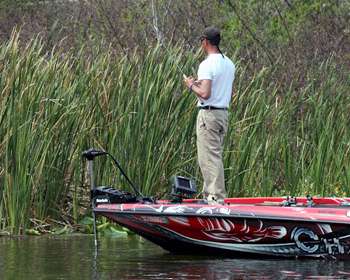
Hunters know that the difference between a successful hunt and coming home empty-handed usually hinges on the ability to get close to the quarry without being detected. When it comes to shallow water bass fishing in clear lakes, the same rule applies.
Slammed lids, dropped rods, trolling motors cranked on high and sonar pings can all turn feeding bass into fleeing bass. Second year Elite Series Pro Casey Ashley knows that subtle actions on the front deck can transmit directly to the behavior of the bass below. Entering the final tournament of the 2008 Elite Series season on Oneida Lake, Ashley needed a high finish to earn a Bassmaster Classic berth. "On Oneida, boat noise is what hurt one of my best areas," says Ashley.
"With five or six other anglers fishing the area, all those trolling motors kicked up mud, cut up the grass, and just stirred up the area. The fish left." Despite the traffic, Ashley adjusted and managed to find enough fish to make the Top 12 cut and earn a trip to the 2009 Classic.
There are several important shallow water tips that can be garnered from Ashley's Oneida experience and applied to everyday angling. One of the first precautions that Ashley takes when entering a shallow water situation is to prepare his boat. "When I go into a shallow area, I adjust my trolling motor shaft up as far as I can to keep the blades from cutting the bottom or grass," says Ashley. "The next thing I do is turn my trolling motor power down as low as I can — just enough to keep moving."
These two steps allow Ashley to quietly slide through the shallow water area without alarming the bass. The South Carolina pro also believes in fishing at a slow, steady pace. If a ceiling fan is constantly turning off and on, you are going to notice it. If it's on a constant speed, it is barely noticeable. "I don't ever want to get over half power on the trolling motor," states Ashley.
"The biggest mistake that I think people make is that they put the trolling motor on high and blast it and let off, blast it and let off. A constant low speed is what works best. That way when I mash the button it doesn't kick up water and make noise but it still moves me around." While electronics play a vital role in many situations, Ashley believes that they may negatively affect shallow water bass.
When fishing shallow, he turns off all of his electronics to further hide his presence. "They can hear the 'tick, tick, tick' that the sonar makes," allows Ashley. "When it's shallow and clear, you have to do everything within your power to not let them know that you are there." Once boat presence has been minimized, Ashley turns to technique and tackle to improve his shallow water chances, particularly when fishing in clear water. When conditions are calm and slick, he makes long casts, staying far enough away to just barely reach his intended target.
"When you are making those long casts, you have to get into bigger line with no stretch and a longer rod so you can get a good hook set from a longer distance," explains Ashley. Even after all these precautions have been taken, spooking shallow bass in clear water remains a strong possibility. With that in mind, Ashley monitors every move that he makes while stalking the shallows. "They can hear it every time you shift your weight on the deck of the boat," he claims.
"If I'm entering an area where I think there are some big fish, I avoid slamming rod lockers or compartments. Anytime you are slamming stuff or knocking stuff around on the boat deck, those fish can hear that."
(Provided by Z3 Media)




